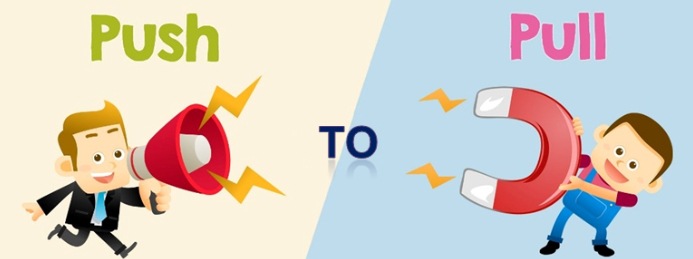Foundations of Traffic Acquisition
Chapter 6

I caught you red-handed, didn’t I? 😁
You just jumped to this chapter because you think digital marketing is only about driving traffic to your website.
You don’t care about the foundation we laid in chapters 1-5. And you probably don’t even care about the rest of this guide.
You just want traffic, like yesterday.
Look, I get it. Getting new visitors to your site is super-important, I’m not denying that.
But, do yourself a favor and don’t jump into traffic acquisition before wrapping your head around the basics.
Sure, your website will get visitors, but you won’t confidently communicate your value or guide them through your conversion funnel efficiently.
Which means you’ll waste a lot of time and money…
You see traffic acquisition is only one slice of the marketing pie.
So, as a word of advice, read this entire guide, and not just this chapter.
You’ll thank me later.
Push & Pull Marketing: Two Sides of the Same Coin
Now that you’ve read the first four chapters, you’re ready to drive new visitors to your website.
Before we dive in, I’ll let you in on a little secret: there are only two ways to do this.
Yes really.
You can either pull them in or push them in. That’s it. No more. No less.

Pull Strategies for Getting Traffic
The first tactic for getting people to your website is to pull them in. This is where you give them a reason to come with you. You entice them, incentivize them, and pull them to your website. This guide is a perfect example of the pull method. You were drawn to us because you want to learn how to find new customers and grow your small business. We didn’t have to hunt you down. When using a pull tactic, you are the content being consumed. You are the checklist people want to use. You are the video people want to watch. You are the blog people want to read. You are the actual goods. Here are the best channels for pulling people to your website:- Content Marketing: Instead of pitching your service, provide relevant and useful content to your target audience. Sharing your expertise and helping people solve their problems will help you become a trusted resource in your industry.
- Email Marketing: Once you capture someone’s email address, use email marketing to build a relationship with them. Guide them through your funnel by providing value at each stage.
- Search Engine Optimization (SEO): Develop a strategy to improve your website’s visibility in search engines. When prospective customers search for information online, your company should be the first to answer these questions.
- Public Relations: Build relationships with local media (journalists, bloggers, etc.) to gain exposure in your city. You’ll want to supply content and thought leadership on behalf of your company.
- Social Media: Develop an active presence on social networks like Facebook, Twitter, and Instagram. Focus on the networks that best position your organization to reach your target audience.
Push Strategies for Getting Traffic
As the name implies, this tactic is a bit more pushy (for lack of a better word) than pulling. Instead of enticing people, you go out and get them. For example, someone may be scrolling through their Facebook feed, and stumble upon your paid ad. They may want to watch a music video on YouTube, but first, they see your ad. Simply put, you go out and find where they hang out online and push them to your website. Push tactics commonly involve interrupting the content that is being consumed OR taking your product/service directly to the customer. Either way, push tactics usually cost money. Which means you must understand the lifetime value of your customers (LTV) and your customer acquisition costs (CAC). As a general rule of thumb, the value of a customer should be three times more than the cost of acquiring them. Here are our favorite channels for pushing people to your website:- Paid Advertising: Run a compelling advertising campaign that targets your audience based on their expressed interests (social media marketing) and demonstrated search history (search engine marketing).
- Lead Generation: Create a killer profile on a local services marketplace or review directory to connect with warm leads and get hired. A few of the more popular platforms are Angie’s List, Home Advisor, Thumbtack, and Yelp.
Choosing the Right Marketing Channel for Your Service Business
Now that you have a solid understanding of the two P’s of marketing, push and pull, it’s important to note that both of these tactics work very well when performed by the right person. I’ll take a wild guess and say that as you were reading about the two, you likely assumed that one tactic was better than the other. But the truth is, they both have their place. In fact, many small businesses use a combination of both. That said, with so many traffic channels to consider, figuring out which one to get behind is really tough. Which is why we’ve created a simple five-step system to help you select the PERFECT marketing channel for your small business.Step One: Brain Storm
The goal during this first step is to come up with reasonable ways you might use each traffic channel. As we JUST mentioned, everyone approaches marketing channels with biases. So this first step is meant to help you overcome your channel biases. It’s important not to dismiss any marketing channel in this step. You should be able to think of an idea or two for every channel at the very minimum – that’s brainstorming in it’s finest form! Regarding research to fuel your brainstorm, this guide is a great start. We’ll cover what marketing strategies have worked in various field-service industries, as well as the history of companies in your space. It’s especially important to understand how companies similar to yours acquired customers over time, and how unsuccessful companies blew threw their marketing budget.Step Two: Rank
This step will help you organize your brainstorming efforts from step one. Now that you’ve come up with ideas for each of the marketing channels place each of them into one of three columns:- Column A (Inner Circle): which marketing channels seem most promising right now?
- Column B (Potential): which marketing channels seem like they could possibly work?
- Column C (Long-shot): which marketing channels seem like long-shots?
Step Three: Prioritize
Now, take a look at your inner circle (column A). If you have three ideas, you’re done! If you have more than three ideas, you need to get rid of some. The reason being that there are a few truly exciting and promising ideas for each channel that emerge from ranking (step two). I draw the line when there is a noticeable drop-off in excitement, and that drop-off usually occurs around the third channel. That said, I want you to have more than one channel in your inner circle because I don’t want you to waste valuable time finding your successful marketing channel by testing channels individually. You can run a few experiments at the same time since tests take some time to run after they’ve been launched. Conversely, testing too many channels at once leads to errors from lack of focus, which means your number needs to be somewhat low. Three is the perfect number for small businesses.Step Four: Test
It’s the moment you’ve been waiting for. This step is where you put your ideas into the real world. The goal of this step is to identify which of the marketing channels from column A is worth doubling down on. You will make that decision based on results from a series of relatively low-cost experiments. The goal of these tests is to answer the following questions.- How much will it cost to acquire customers through this marketing channel?
- How many customers are available through this marketing channel?
- Are the customers that we get through this channel the ones that we want right now?

Keep in mind that, when testing your ideas, you are not trying to crush it with a particular marketing channel just yet…
Instead, you are simply trying to discover if it’s a channel that MIGHT work for your small business.
Your main focus at this point is speed. Did you win or did you learn?
You want to launch smaller tests that don’t require much upfront time or money.
For example, run three Facebook ads instead of thirty.
You should be able to get a rough idea of whether a channel works or not for your business with just a few hundred dollars.
Step Five: Focus
If all goes well, one of the marketing channels you tested in your inner circle showed promise (fingers crossed).
If that’s the case, you should put all of your marketing efforts and resources behind that particular channel.
The reason why I suggest focusing on one channel at a time is simple: if it ain’t broke, don’t fix it.
As you dive deeper into your chosen channel, you will uncover ways to become even MORE effective within that channel.
Until it stops working.
It’s hard to tell when this will happen, but marketing channels usually fall victim to diminishing returns for one of two reasons:
- Saturation.
- Rising costs.
So enjoy the ride and wring every bit of traffic out of the marketing channel until the well runs dry.
Repeat the Process
If no channel showed promise after testing, don’t get discouraged by the initial results.
It’s ok to be optimistic when setting your SMART goals (it keeps me going too), but you can’t get frustrated every time an experiment produces mediocre results.
Most of the experiments simply won’t work. That’s why your SMART goal should be attacked from multiple angles.
The good news is that even if an experiment fails you will have undoubtedly gathered a lot of information about that channel and your company.
This information can be used in future experiments and will inform you as to what types of things are, and are not, working with your target audience.
Here’s a shining example: Thomas Edison failed more than 1,000 times when trying to create the light bulb.
When asked about his failures, Edison said, “I have not failed 1,000 times. I have successfully discovered 1,000 ways not to make a light bulb.”
As you know, Edison eventually succeeded in this endeavor and went down in history as one of the greatest inventors of all time.
So it goes without saying that you will learn from your successes, and you will learn from your failures.
So if you failed to find a viable marketing channel your first time around, pick up the pieces and repeat the process starting at step one.
Chances are you’ll strike a chord sooner than you think.
Ready to Get Started?
Get all our amazing features and top-rated support, with no credit card required.
